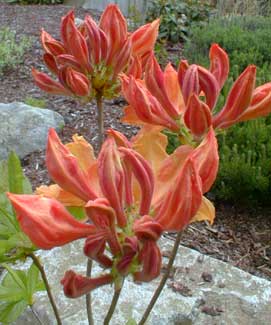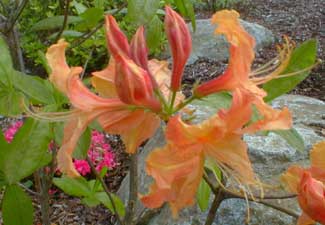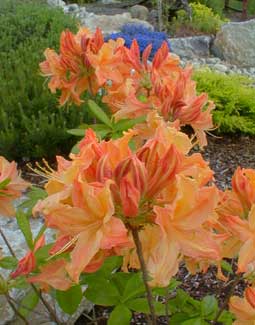
'Golden Lights'
Deciduous Azalea
"Azaleas nestled 'neath the Georgia pines
And when I see this earth for my last time
I'll have Augusta, sweet Augusta on my mind."
-Billy Mac,
1998
1998
'Golden Lights' was bred from an unnamed Rhododendron atlanticum hybrid seedling, pollinated by an unnamed Exbury azalea. It grows three to six feet high & wide in ten years, with spreading habit.
It will do well in considerable sun, but has a preference for bright shade, filtered sunlight, or morning sun, & can even do fairly well in somewhat deeper shade. Full afternoon sun can result in bleached leaves & shortened flowering period.
Introduced in 1986, this is one of the "Lights" Hybrid series developed at the University of Minnesota. It is extremely cold-hardy (to minus 40 degrees F.) & can be grown much further north than most azaleas.
 The quest to develop the ultra-hardies Lights azaleas was started in the 1930s by Albert G. Johnson, joined later by Leon Snyder, & carried on for a quarter-century beginning 1957 by Harold Pellett.
The quest to develop the ultra-hardies Lights azaleas was started in the 1930s by Albert G. Johnson, joined later by Leon Snyder, & carried on for a quarter-century beginning 1957 by Harold Pellett.The first "Lights" varieties were released in 1978, so it was a long journey that began with instilling hardiness by selecting azalea species that grew furthest north for the breeding program, & when hardiness was established, further selection & breeding for compactness, floriferousness, & disease resistance; & last of all, further development for striking colors.
The Minnesota project continues to this day, with plans to develop such things as a true red deciduous azalea & varieties that bloom later in the summer. Further research also goes on here in the Pacific Northwest, in Oregon's Willamette Valley.
 Though shrubs from this series are quite sturdy in the harsh winters of the upper midwest, they do not require such hardship to thrive, & are even happier in our mild Northwest seasons, though above Zone 8 they would not be as reliable since they have not been bred for heat-hardiness.
Though shrubs from this series are quite sturdy in the harsh winters of the upper midwest, they do not require such hardship to thrive, & are even happier in our mild Northwest seasons, though above Zone 8 they would not be as reliable since they have not been bred for heat-hardiness.'Golden Lights' is notably mildew resistant, though unless crowded or kept too wet late in the season, mildew shouldn't be a problem with any azalea grown in the Northwest.
Care should be taken that they not dry out entirely during a droughty summer. An organic mulch can help hold in soil moisture & a pale mulch choice, such as of pine shavings or fir needles dried to fawn color, will keep the shallow root system from being overheated. Good drainage is required, as soppy soils result in root-rot.
Bi-color orange & red-orange buds open into fragrant golden or butter-yellow flowers with salmon-pink to orange highlights. They begin in May just before the leaves unfold, & last until the leaves are out. The size of each bloom in the truss is less than two inches, but so numerous that the trusses are enormous.
A young specimen may need some post-flower terminal pruning to induce multiple branching, but a mature shrub rarely if ever needs any pruning at all.